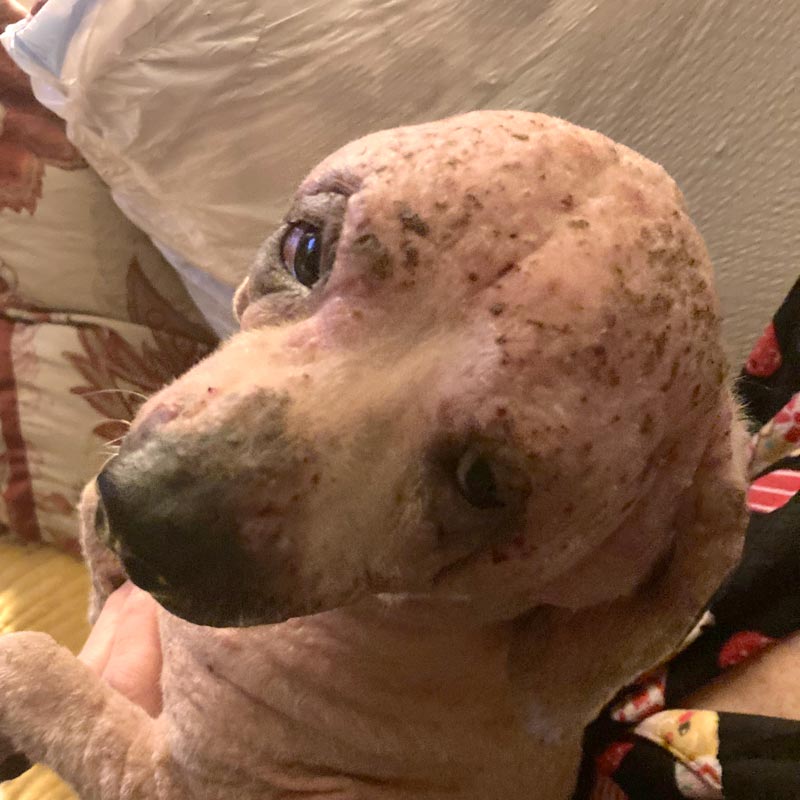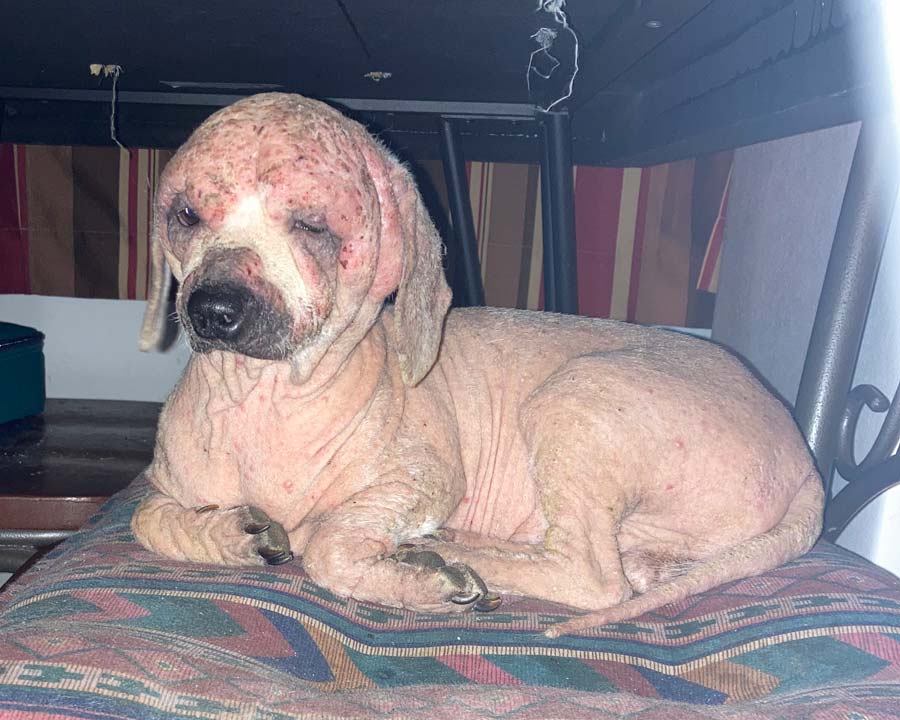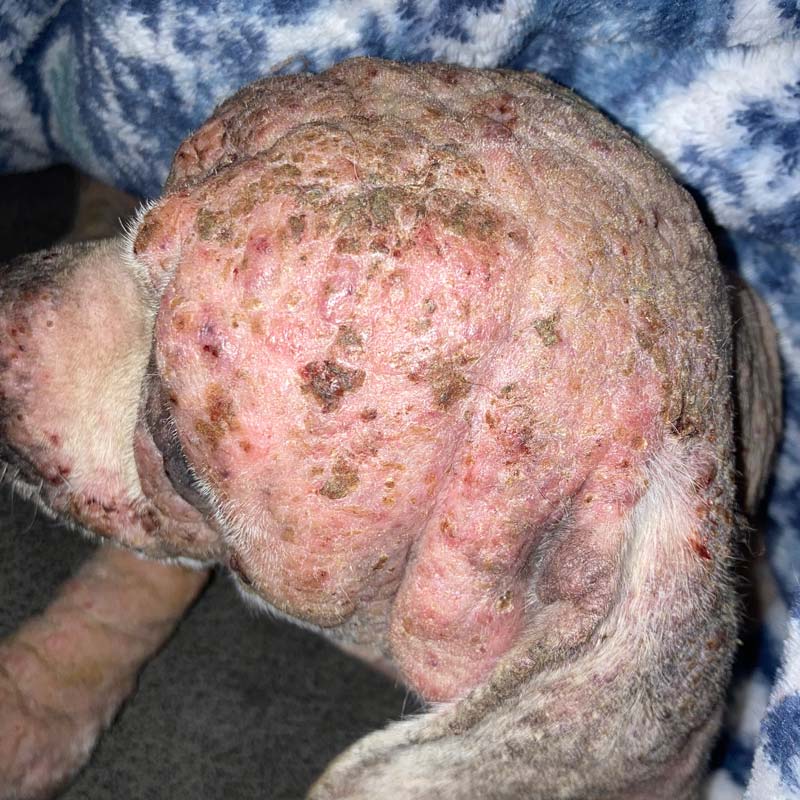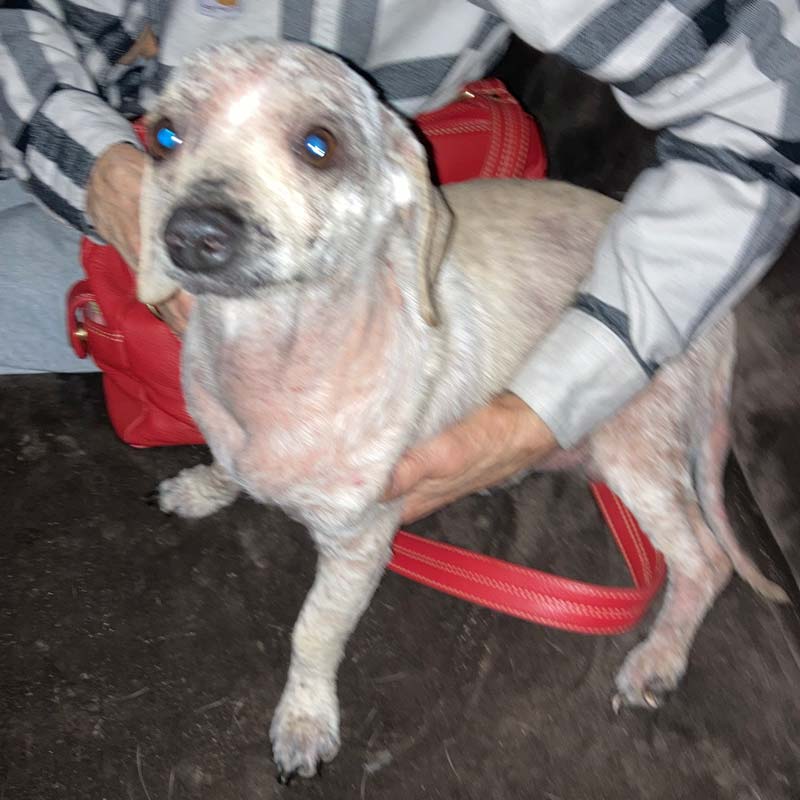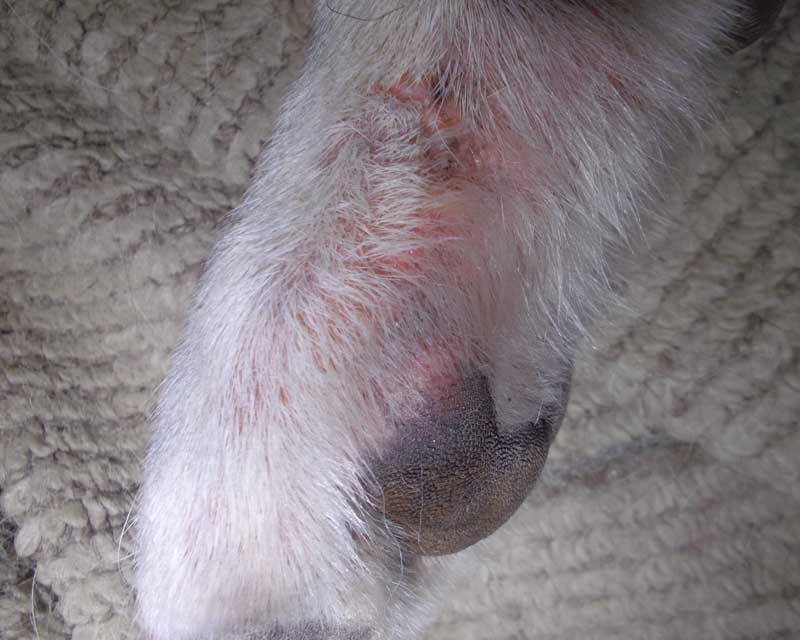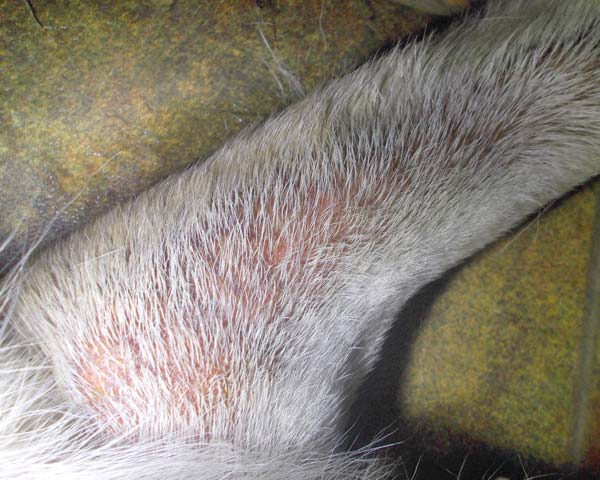It Mite Be Mange: Photos, Causes, Symptoms + Treatment
Remember, this is an educational resource, not a guide for diagnosis.
Pictures are helpful, but they may not tell the whole dermatological story. We always recommend consulting with your vet for any of your dog's health concerns.
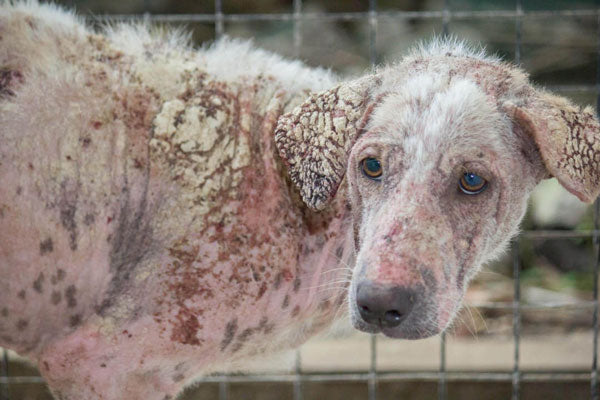
What is Mange?
Mange is a skin disease caused by microscopic parasites called mites. The word comes from the Old French mangeue, meaning "eat" or "chew."
There are two main types of mange that affect dogs, each named after the specific mite that causes it: demodectic (demodicosis, demodex, or red mange) and sarcoptic (scabies). Though they share some similarities, and can exhibit similar symptoms, they have different treatments and prognoses.
Photo: Dog with mange and secondary infection; via International Aid for the Protection & Welfare of Animals (IAPWA)
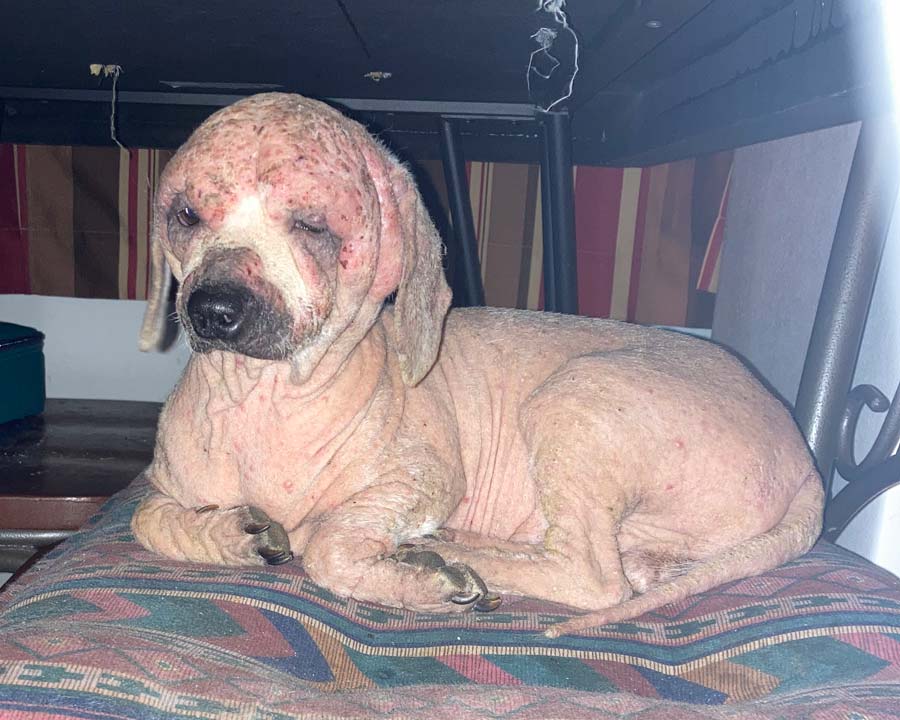
What Does Mange Look Like on Dogs?
Mange can be one of the ugliest skin diseases to see, making a dog virtually unrecognizable in severe cases. As the mites spread, one of the first noticeable signs - especially with demodectic mange - is spreading fur loss (alopecia).
Over time, the skin may begin to exhibit inflammation and redness as the immune system tries to combat the invasion. Patches of darkened skin (hyperpigmentation), scaly, hardened lesions, and scabs often form as the skin becomes more sensitive and damaged as the dog scratches or rubs the skin.
With such a strain on the immune system, bacterial (pyoderma) and yeast (Malassezia) infections can easily get established and exacerbate the problem.
Photo: Dachshund mix with demodectic mange, inflammation, and hardened skin; via customer
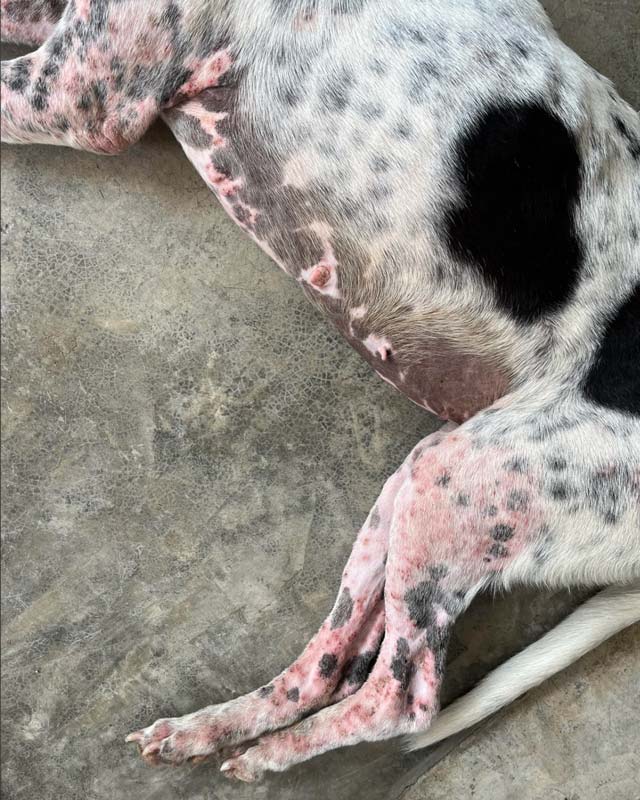
A Word of Caution on Canine Mange
Before we go further, it's vital to note that mange is not as common as you might expect. Many people see a patch fur loss on their dog and immediately think "MANGE!", but this is often not the case.
These skin conditions can also create fur loss, inflammation, severe itching, dark patches, and scaly skin:
- Allergy dermatitis
- Ringworm
- Yeast dermatitis
- Pyoderma
- Cheyletiellosis (less common)
In most cases, these tend to be the actual culprits.
The only way to know for sure if your dog has mange - whether demodectic or sarcoptic - is by veterinary diagnosis. Read on to learn about each form and how they are diagnosed.
Photo: Dermatitis with spreading lesions on legs and belly, possibly due to mange mites or other parasitic infestation; via r/DoYaFeelLuckyPunk on Reddit
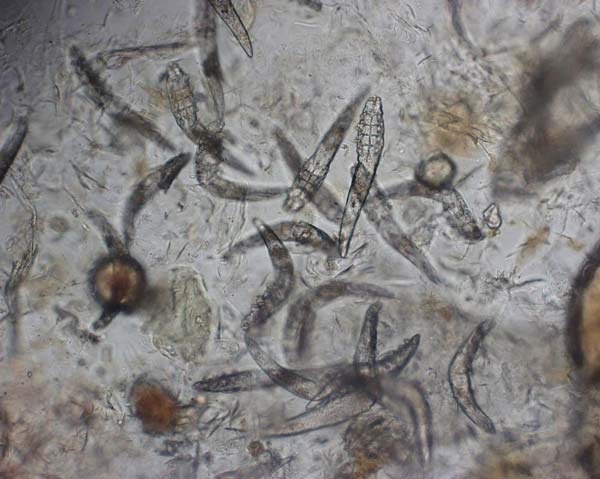
Demodectic Mange
Demodectic mange (demodicosis, demodex, or red mange) is the most common form of mange in dogs. The cigar-shaped demodex mites are part of the normal array of microbes that live on dogs' skin, inhabiting hair follicles and sebaceous glands (another part of hair follicles).
A normal immune system keeps the mites in check, and they cause no problem unless they grow out of control due to a weak or suppressed immune system. Demodex occurs most often to puppies less than 18 months old whose immune systems have not fully developed.
Demodectic mange can happen to seniors with weaker immune systems or to adults with underlying health issues, such as malnutrition, cancer, hypothyroidism, or diabetes.
Photo: Demodectic mange mites under microscope, by Dr. Michael W. Dryden, DVM, PhD, DACVM; via the Merck Veterinary Manual
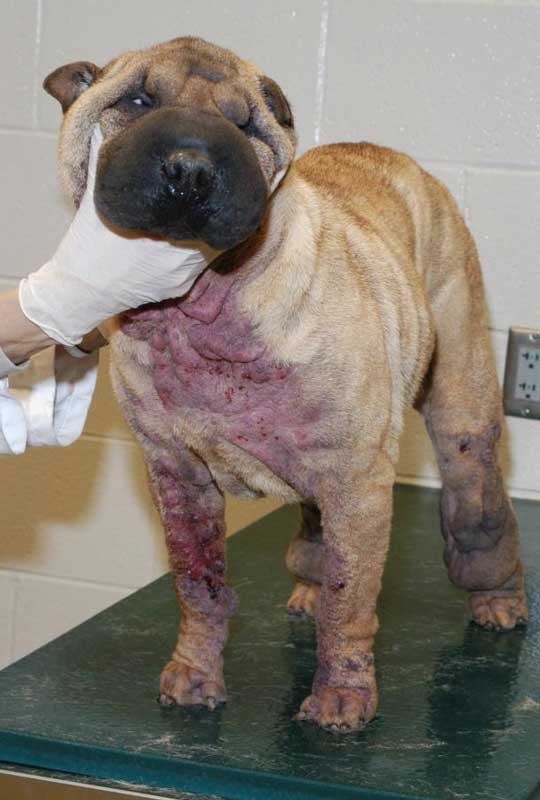
Is Demodex Mange Contagious?
Demodex mange is not contagious - either between dogs, other animals, or humans. Nearly all dogs carry demodex mites, as they are transferred from their mother shortly after birth.
Because the immune system (abnormalities included) is transferred genetically, it is strongly believed that demodex mange is hereditary. It is recommended that dogs affected by demodectic mange should not be bred, and the parents shouldn't be bred again.
Photo: Shar pei with juvenile demodicosis, by Dr. Michael W. Dryden, DVM, PhD, DACVM; via the Merck Veterinary Manual
Lavengel® and Demodex Mange: Mistro's Story
Collapsible content
Read what Mistro's family had to say
"My mother's dog Mistro had demodetic mange and has scabs all over his body and was healing slowly until using this [Lavengel®].
We were afraid initially he may have to be euthanized because nothing was helping him get better. He was miserable and hid under a blanket all the time.
His recovery process has been about six weeks so far, but since we found your product, he is no longer itching and rubbing himself raw like he was. It was just the added thing we needed with the medication from the vet to add the umph in his healing process.
Mistro is recovering very quickly and has grown his hair back fast!!! The vet was mindblown. Thank you for what you do!"
-- Dana D.
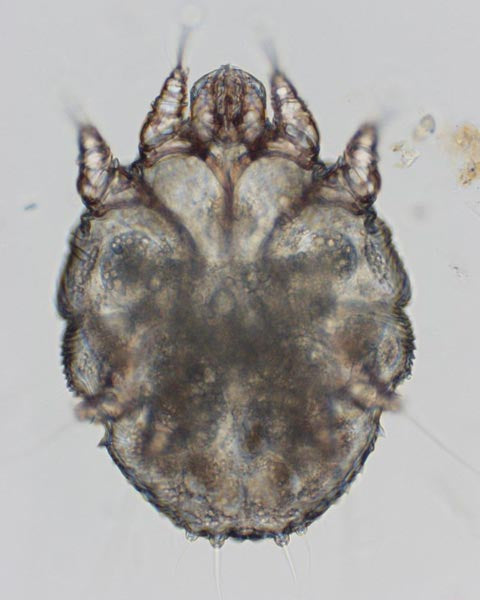
Sarcoptic Mange
Sarcoptic mange, or scabies, is caused by the Sarcoptes scabiei mite, which resembles a microscopic tick with stubby legs. Unlike demodex mites, which are associated with hair follicles, scabies mites burrow anywhere into the skin, feed, and breed quickly.
Scabies can affect all ages and breeds of dogs, causing intense itching. They tend to attack the ear margins, elbows, and ankles, then spread. Dogs constantly chew and scratch to stop the itch, leading to hair loss, redness, and lesions of dark (hyperpigmentation) and hardened skin (lichenification).
Symptoms might appear as soon as 10 days or as late as 8 weeks after contact. If scabies is left untreated, it can result in emaciation, infection, and eventual death.
Photo: Scabies mite under microscope, by Dr. Michael W. Dryden, DVM, PhD, DACVM; via the Merck Veterinary Manual
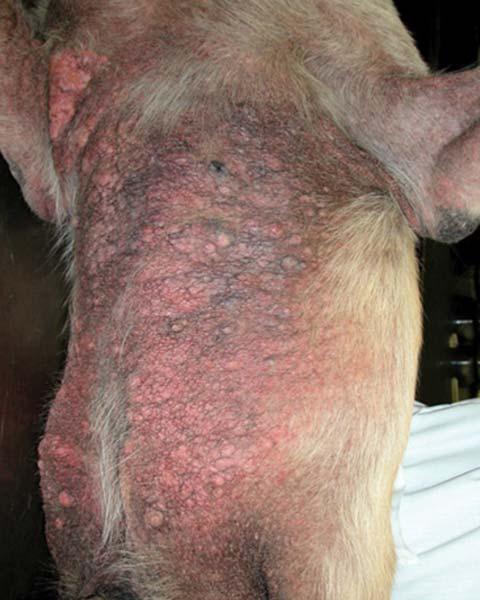
Is Sarcoptic Mange Contagious?
Yes, scabies are highly contagious - another difference between it and red (demodex) mange. They are typically picked up from other animals (such as foxes or coyotes) that are infected, and they can even be acquired from shed fur or bedding.
Scabies are zoonotic, meaning they can affect animals other than dogs - yes, including humans. While the scabies mites cannot complete their life cycle on humans like on dogs, they can make life miserable for several days.
It's important that any bedding, collars, clothing, or fabrics that your dog comes into regular contact with are frequently washed or discarded to prevent re-infection.
Photo: Sarcoptic mange with fur loss, redness, and lichenification on dog's torso and hips; by Adam P. Patterson, DVM, DACVD; via Clinician's Brief
Lavengel® and Scabies: Gunner's Story
Collapsible content
Read what Gunner's owner had to say
"The very first time I put your gel on Gunner, IMMEDIATELY, he calmed down, was able to sleep, and not be scratching or biting all of his allergic [scabies] spots. AMAZING!
He eased and finally got some good sleep... It is helping, even visibly noticeable for the loss of the terrible redness he originally had.
The original problem turned out (after 3 trips to the vet) from being infested by sarcoptic mange mites that we got here from mange-carrying foxes on our farm.
But your cream [gel] helped tremendously along with the prescribed treatment after he was properly diagnosed with those mites."
-- Alberta S.
Key Symptoms of Mange in Dogs
Demodectic:
- Patches of spreading hair loss (alopecia), typically beginning on the face
- Redness, acariasis (rash), with scaling skin
- Swelling, infections, crusts
- Itching is common, but may not be severe
Sarcoptic:
- Extreme itching
- Spreading hair loss
- Redness, rash, infection
- Scabs and hyperpigmentation (dark areas)
- Yellow crusts and skin thickening/hardening
- Itching, pain, and sensitivity
Secondary bacterial (pyoderma) and yeast (Malassezia) infections are common with severe cases of both forms of mange.
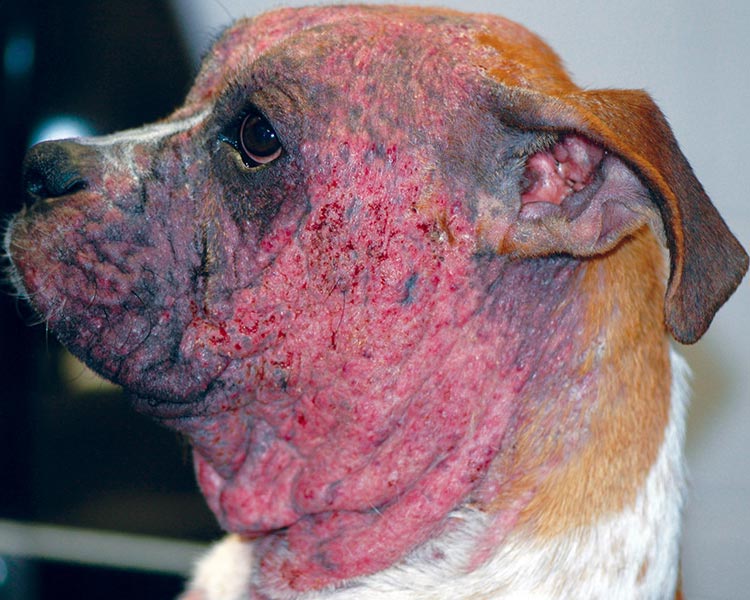
How Is Mange in Dogs Treated?
We highly recommend seeking veterinary consultation, as mange can spread quickly.
Your vet will take skin scrapings to determine if, and what type of mange is present. Sometimes, multiple scrapings may be needed, as scabies mites can "hide."
With demodex mange, treatment depends on whether it is localized (a few patches) or generalized (all over). The localized form is often treated with topicals and medicated shampoos. There have been many cases where localized red mange has resolved on its own - that is, the dog's immune system was able to stop it before it could spread further.
Both scabies and the generalized form of demodex mange call for more aggressive treatment to stop the infestation, cleanse the skin, and address secondary issues that may have arisen from the damaged skin - such as bacterial and/or yeast infections.
Several oral and topical treatments that veterinarians may consider for mange are:
- Topical: selamectin, moxidectin-imidacloprid, topical fluralaner
- Injectable: doramectin
- Oral: milbemycin oxime, afoxolaner, fluralaner, and ivermectin (cannot be used for many herding breeds)
Humans that have been exposed to scabies should consider consulting with their doctor.
Photo: Demodex mange with swelling, redness, and discharge; by Sandra Koch, DVM, MS, DACVD, via Today's Veterinary Practice
Mange in Dogs FAQs
How do dogs get mange?
The two forms of mange are caused by two different species of microscopic mites.
Demodectic Mange
Demodectic mange (or demodicosis) is caused by an overpopulation of Demodex canis mites that normally inhabit the hair follicles of nearly all dogs. This tends to occur when:
- The immune system is weak (in puppies and senior adults) and cannot regulate the mite population like normal, healthy dogs
- The immune system is suppressed or compromised due to a severe systemic infection or debilitating disease such as cancer, hypothyroidism, Cushing's disease, or diabetes mellitus
Lastly, there is strong evidence that demodectic mange is genetically inherited, and it is recommended that dogs with demodicosis should not be bred.
Sarcoptic Mange
Sarcoptic mange, or scabies, is caused by Sarcoptes scabiei mites that feed on skin and hair. Scabies is highly contagious, and acquired via:
- Contact with another animal carrying the parasites, such as other dogs, foxes, coyotes, or even humans.
- Contact with bedding, loose fur, fabrics, or other articles that the carrier animal has laid on or brushed against
What are the symptoms of mange in dogs?
Mange comes in two forms, both of which exhibit similar symptoms:
Demodectic mange:
- Patches of spreading hair loss (alopecia), typically beginning on the face
- Redness, acariasis (rash), with scaling skin
- Swelling, infections, crusts
- Itching is common, but may not be severe
Sarcoptic mange (scabies):
- Extreme itching
- Spreading hair loss
- Redness, rash, infection
- Scabs and darkened areas (hyperpigmentation)
- Yellow crusts and skin thickening/hardening (lichenification)
- Itching, pain, and sensitivity
It is worth noting that mange is not terribly common, and other skin conditions can exhibit similar symptoms, such as:
Do flea and tick products help with mange?
Some can, yes - though it is an off-label use.
Many prescription flea and tick products from brands such as NexGard®, Bravecto®, Simparica®, and Interceptor® contain ingredients that are effective at killing and repelling mange mites, such as:
- Selamectin
- Moxidectin-imidacloprid
- Fluralaner
- Milbemycin oxime (Interceptor®)
- Afoxolaner
These products can also be helpful with Cheyletiellosis, also known as walking dandruff, which is caused by another form of parasitic mite.
Is mange in dogs contagious?
Sarcoptic mange (scabies) is HIGHLY contagious in dogs, and can be spread easily between dogs and humans.
Demodectic mange, on the other hand, is not considered contagious among dogs.
Is mange in dogs itchy?
Demodectic mange can cause mild to moderate itching - sometimes none at all, depending on the case.
Sarcoptic mange (scabies), on the other hand, is extremely itchy.
Will my dog's mange go away on its own?
Localized forms of demodectic mange - that is, small random patches - can be left untreated and natural recovery happens frequently as the dog's immune system corrects the overpopulation of mites.
Generalized (all over the body) demodex mange will require treatment. Because it is so uncommon in healthy adult dogs, veterinarians will also see if there is an underlying condition or disease that has led to the demodicosis.
Scabies (sarcoptic mange), will not go away and should be treated by a veterinarian immediately to prevent spread and save the dog (and you) from a lot of itching and misery.
Can Lavengel® help with canine mange?
We do know that Lavengel® can be extremely useful in relieving the itch and irritation caused by mange, helping the skin to heal, and aiding in fur regrowth.
However, we have not conducted the research to test its efficacy against the mange mites themselves.
We have two confirmed testimonies in which Lavengel® was used on mange - both found in more detail in above sections.
One (Mistro) involved applying our gel to highly itchy scabs and lesions caused by demodex mange. In Mistro's case, it was noted that Lavengel® helped stop the intense irritation and helped his skin heal and fur grow back so quickly that his vet was astonished.
The other (Gunner) involved applying our gel to a case of scabies on his paws, feet, and legs. His owner noted that from the very first time Lavengel® was applied, he settled down, left the lesions alone, and was able to sleep. She also noticed that it reduced the overall redness of the affected skin.
So yes, Lavengel® can help with mange.
But, it should be noted that in both instances, Lavengel® was used in conjunction with treatment prescribed by the vet.
What's the difference between mange and yeast dermatitis?
Mange is caused by two different species of parasitic mites, whereas yeast infections are caused by a fungus (Malassezia pachydermatitis). Yeast and mange require very different forms of treatment. You can get a lot more info on the two types of mange on our Yeast Resource Page.
Since both types of conditions - in their severe forms - can result in hair loss, severe itching, hyperpigmentation (dark coloring), and scaly skin, these two conditions are often confused. In fact, a severe mange mite infestation can lead to secondary pyoderma and yeast infections.
It should be noted that, in general, mange is rather uncommon, and occurs much less frequently than yeast dermatitis.
What's the difference between mange and ringworm?
Ringworm and demodectic mange can sometimes be confused because they both tend to exhibit spreading patches of hair loss (alopecia), especially around the face. Both diseases feed on hair follicles and can exhibit mild itching or none at all.
Some of the key differences between ringworm and demodectic mange:
- Ringworm is a fungus; mange is caused by parasitic mites
- Ringworm is extremely contagious to humans and other animal species, whereas demodectic mange is not
- Ringworm can affect any dog; demodex mange tends to only affect dogs with weak or compromised immune systems
- Ringworm will cause hair follicles to glow bright green under a Wood's lamp; mange will not
- While both involve skin and hair cytology in diagnosing, ringworm requires a fungal culture to properly diagnose and monitor treatment progress
What's the difference between mange and walking dandruff?
Walking dandruff (cheyletiellosis) is a skin condition caused by Cheyletiella mites, whereas mange is caused by either Demodex or Sarcoptes mites.
Similar to Demodex mites, Cheyletiella mites live and multiply on hair follicles, feeding on dead skin and detritus. The most common symptoms of walking dandruff are (you guessed it) excessive dandruff, mild to severe itching, and patchy fur loss.
Similar to Sarcoptes mites, Cheyletiella mites are zoonotic and can be transferred to and from humans. However, they cannot complete their life cycles on humans.
See our Walking Dandruff in Dogs Resource for more info.
Can humans get mange from dogs?
Yes and no.
Scabies (sarcoptic mange) can be spread easily between dogs and humans.
Unlike in dogs, the mites cannot complete their life cycle in humans, so they will eventually die. However, they will bring about extreme itching for several days, and it is recommended that people who contract scabies consult a doctor.
Demodectic mange in dogs, however, cannot be spread to humans.
Can I see mange mites on my dog without a microscope?
Sarcoptic mange (scabies) mites can barely be seen with the naked eye at 0.2-0.6mm long. They may resemble tiny black dots on the skin, and can easily be confused with dirt.
Demodectic mites are semi-transparent and too small to be seen with the naked eye.
Can a dog die from mange?
It is possible for dogs to die from sarcoptic mange (scabies), though it is extremely unlikely. The mange itself would not be considered the probable direct cause of death.
It is more likely for a fatal systemic infection to develop because of, or in addition to, a generalized (covering the body) case of the disease.
Dogs that reach this state are typically neglected and suffering from malnutrition, infection, emaciation, and other underlying disease that overpowers the immune system.
More Canine Skin Issues to Study
-
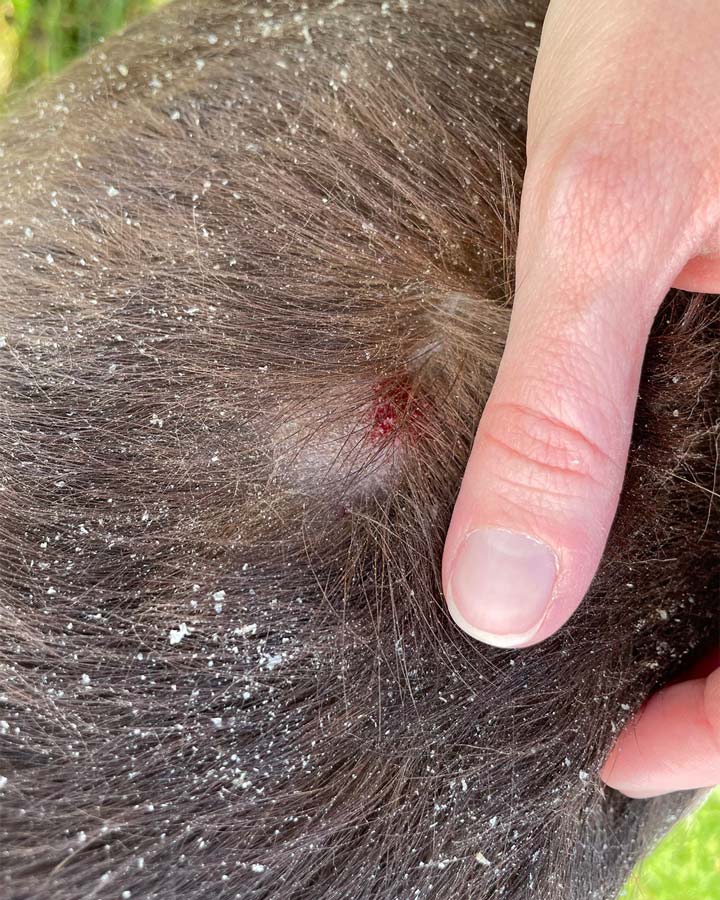
Walking Dandruff
Those aren't frosted flakesAlso known as cheyletiellosis, this flaky skin condition is caused by a mite of the same order of classification as Demodex mites.
-
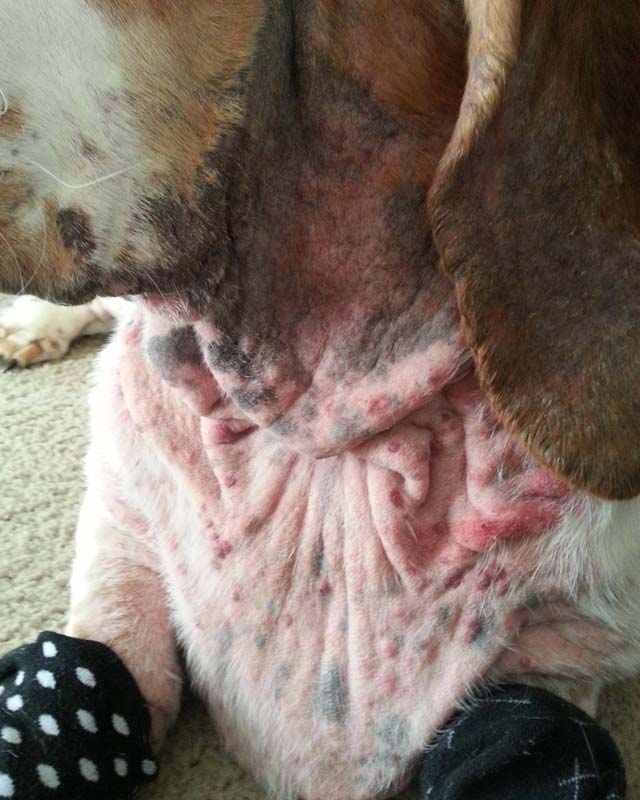
Yeast Infections
Yeast can be a real beastYeast infections can affect the skin (dermatitis), ears (otitis), and paws, and are caused by a fungus called Malassezia.
-
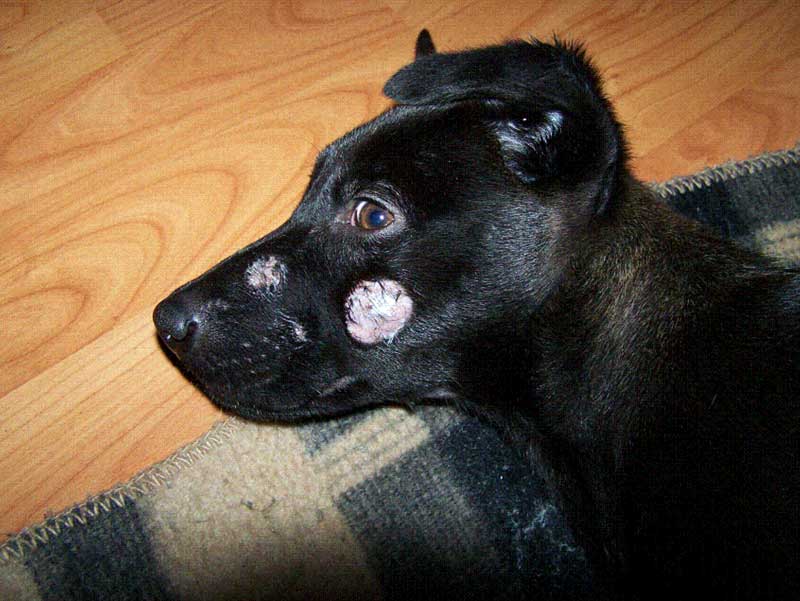
Ringworm
This worm is actually a germDespite the name, ringworm is not a parasite, but fungus caused by three different species. It can even be spread to and from humans.
Collapsible content
Resources on mange in dogs
- Cornell University Riney Canine Health Center: Sarcoptic Mange (Scabies)
- VCA Animal Hospitals: Demodectic Mange in Dogs
- VCA Animal Hospitals: Sarcoptic Mange in Dogs
- Merck Veterinary Manual: Mange in Dogs and Cats
- American Kennel Club: Mange in Dogs
- International Aid for the Protection & Welfare of Animals (IAPWA): What is Mange?
- Today's Veterinary Practice: Updates on the Management of Canine Demodicosis
